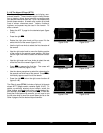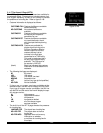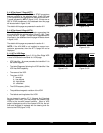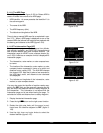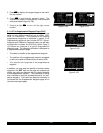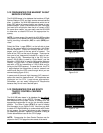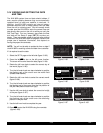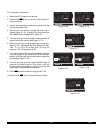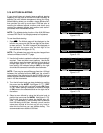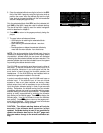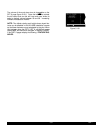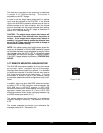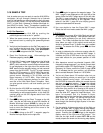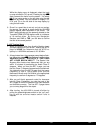
3-55
Rev 1
3.15 ALTITUDE ALERTING
If your aircraft does not already have an altitude alerting
capability you may wish to use the KLN 90B’s capability of
assisting you with altitude management during your flying.
Altitude alerting allows you to select a target altitude and it
then provides you with an aural alarm 1000 feet prior to
reaching the selected altitude, another aural alarm upon
reaching the selected altitude, and another aural alarm if
you deviate from the selected altitude.
NOTE: The altitude alerting function of the KLN 90B does
not meet FAR Part 91 for turbojet-powered civil airplanes.
To use the altitude alerting:
1. Press A. The Altitude page will be displayed on the
left with the cursor over the first two digits of the altime-
ter baro set field. The NAV 4 page will be displayed on
the right with the cursor over the first digit of the
selected altitude field (figure 3-175).
NOTE: The altimeter baro set units may be changed from
inches to millibars on the SET 7 page.
2. Use the left knobs to update the altimeter baro setting if
required. There are three cursor positions. Use the left
outer knob to move the cursor and the left inner knob to
change digits (figure 3-176). With the proper altimeter
baro setting, the indicated altitude (IND) on the right
should be the same as the aircraft’s actual altimeter.
NOTE: There may be some difference (less than 100 feet)
between the indicated altitude (IND) and the aircraft’s
actual altitude if the altitude input to the KLN 90B is from an
altitude encoder because these encoders only provide alti-
tude in 100 foot increments.
3. Turn the left outer knob one step clockwise to position
the cursor over the ALERT: field (figure 3-177). If OFF
is displayed, turn the left inner knob to select ON (figure
3-178). When alerting is enabled, an arrow to the right
of ON points to the selected altitude on the right side of
the screen.
4. Select a warn altitude by using the left outer knob to
position the cursor over the WARN: field (figure 3-179).
Use the left inner knob to select the desired warn alti-
tude. It is selectable in one hundred foot increments
from 200 feet up to 900 feet. Normally, you will use the
same warn altitude all the time so you only have to
enter this the first time you use altitude alerting. The
recommended warn altitude is 300 feet.
ALTITUDE |VNV INACTV
BARO:30.13"|
ALERT: OFF|IND 09000ft
|SEL:05500ft
|KMKC :-00nm
|ANGLE:-1.3^
CRSR enr-leg CRSR
Figure 3-175
ALTITUDE |VNV INACTV
BARO:30.09"|
ALERT: OFF|IND 09000ft
|SEL:05500ft
|KMKC :-00nm
|ANGLE:-1.3^
CRSR enr-leg CRSR
Figure 3-176
ALTITUDE |VNV INACTV
BARO:30.09"|
ALERT: OFF|IND 09000ft
|SEL:05500ft
|KMKC :-00nm
|ANGLE:-1.3^
CRSR enr-leg CRSR
Figure 3-177
ALTITUDE |VNV INACTV
|
BARO:30.09"|IND 09000ft
ALERT: ON =|SEL:05500ft
WARN:±300ft|KMKC :-00nm
|ANGLE:-1.5^
CRSR enr-leg CRSR
Figure 3-178
ALTITUDE |VNV INACTV
|
BARO:30.09"|IND 09000ft
ALERT: ON =|SEL:05500ft
WARN:±300ft|KMKC :-00nm
|ANGLE:-1.3^
CRSR enr-leg CRSR
Figure 3-179



